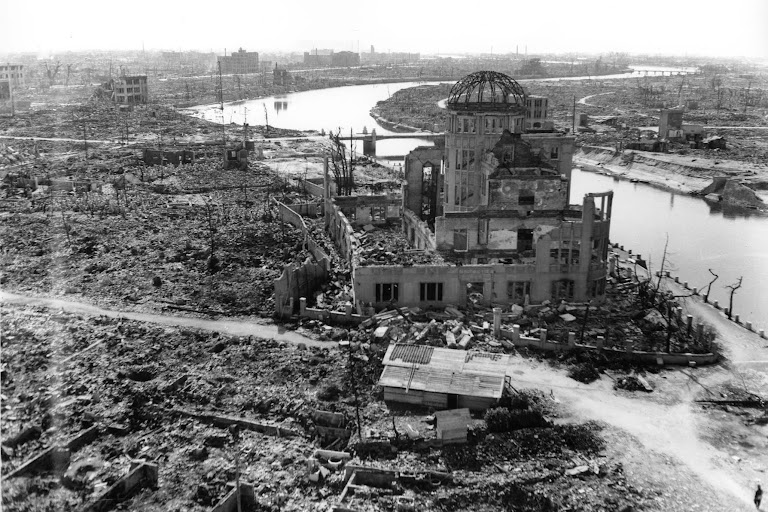JAPAN – Kyusu, South Honshu March 14-20
Another country, my twelfth this winter. Another currency (worth about 100 yen to the $US), driving on the left, another language that I don’t know a word of, and a people who speak virtually no English. A culture radically different from what we know in North America. If you put us in the middle, India would be on one end of the cultural spectrum and Japan at the other. A script that is indecipherable and little is written in English unlike every other country visited this winter. I am getting tired with my intense travel style and Japan will be the most intense of all with my obsession to use my Japan Rail Pass to its ultimate. I am looking forward to a few days in Bangkok at the end where I plan on doing nothing.
The superfast hydrofoil ferry took only 3 hours to travel from Busan, Korea to Fukuoka, Japan. It was uncommonly smooth and was appreciably cheaper (137,000 won) than flying (270,000 won), an easier entry into the city and fewer immigration hassles. I used the only space remaining in my totally full passport and now really only have a tiny corner on one page for my Japan exit stamp. Fukuoka (pop 1,500,000) is the biggest city in Kyusu province (and the 6th biggest in Japan). Kyusu is the most southern and western of Japan’s main islands.
TIPS FOR JAPAN
1. Japan Rail Pass. I have a 21 day Japan Rail (JR) Pass, one of the best travel deals on the planet. Available only to foreigners, it can also only be purchased outside the country. After exchange and a 4% credit card charge, it cost $631 Canadian. It can be used on all trains (and some JR ferries and buses) except for the super express Nozomi service (these only stop at major stations). The normal Shinkansen (bullet) trains are very fast but will stop at most stations. Just flash the pass as you go through the gate and ask for the track for your destination. I am keeping track of all the costs and should be able to get into the $1500 range with all the travel I have planned. This is going to be the most intensive travel I have ever done as I hope to see all of Japan and maximize my pass. Simplified English train schedules aren’t available. But the internet site www.hyperdia.com is very good. Put in your stations and departure time and you get complete lists of the routes available, times, costs and transfers. The trains are so frequent that a schedule is almost not necessary. You rarely need to wait more than 30 minutes even for the super express trains.
Just to show you how crazy it is, I was totally unable to find a room in Kyoto on March 21 (a National holiday, Equinox Day), although I had one on the 20th and 22nd and was booking a week ahead. One of the problems is that I can’t stand paying more than $35/night for a room. Looking at staying in an internet cafe (they have reclining chairs) or on the floor in the train station, I decided to try all the cities around. As the trains are so fast and frequent, staying anywhere within an hour (Osaka, Nara, Nagoya, Kobe) would be no problem. There were no rooms even in the cheap business hotels (that still cost $50-70), so I was contemplating staying as far away as Tokyo as it is only 2 3/4 hours from Kyoto. Catch the 6AM and 7PM train and I would still have 12 hours in Kyoto. JR passes make travel so easy. With the help of a nice young Japanese woman, I was able to find a capsule hotel in Nagoya (home of Toyoto and 3/4 of an hour away) on a web site only in Japanese for March 21st.
Activate your JR Pass after visiting a place that you may be staying at for a few days like Kyoto, Tokyo or Kagoshima (where a trip to Yakushima on the north of Okinawa will consume 3 days or so with the two ferry rides and at least one day of hiking). Save one of these places also for your last day of travel for the same reasons. The most efficient use of the pass would be to activate it after seeing Kyoto and then arrive in Tokyo at the end leaving 2-3 days to see it after your pass has expired.
JR trains leave exactly on time – to the second. One is very dependent on the guys at the gates to find out the train departure times, whether Shinkansen or local train, which track it is leaving on, and what cars are unreserved. Most of the time it is not necessary to reserve a seat as there are so many trains but on weekends and holidays, a reservation would be a good idea. Over time, I did find it easier to make reservations – you have a guaranteed seat, and you know when your train arrives. With local trains, it is more often necessary to get a ticket with a reserved seat. You cannot rely on locals to answer any questions but writing down your problem may result in an answer. The non-Shinkansen trains allow a much more intimate look at the surrounding countryside. Stops are very brief so if you get off to have a quick smoke, don’t wander far from the door. A bell usually sounds just before the door is to close. More than once, I was caught in the door and got in just in time.
2. Information. japan-guide.com is useful for everywhere. Stop at the information centres in each JR terminus, pick up a city map, bus or tram schedule and a metro guide and you are all set. Usually day or multi-day transportation passes are available for each city and can be a reasonable deal if using public transport a lot.
3. Accommodation. Always try to get accommodation near the main JR station in each city. You will be travelling through there all the time and most transportation to the tourist sites is easy to access from them.
Hostels are in all the big cities and usually cost 2000-3000 yen. Book through Hostelworld, cheaphostelsjapan.com, booking.com or agoda.com. Book as soon a possible for Kyoto, Tokyo, Hiroshima, over any holidays or the busy travel times and often on weekends. Unfortunately hostel behaviour from Japanese and especially the many Chinese travellers is often atrocious. They stay out late, think nothing of turning on the lights, talking, packing in the room etc.
If wanting a cheaper sleep yet, a good option if these are all booked out are internet cafes. Surprisingly they offer reclining beds or tatami mats, have computers and TVs that can be booked for the night. Some even have showers. Store your pack in the lockers at the JR stations during the day. Another option if all else fails might be on the floor at JR stations.
Toyoko Inns (toyoko-inn.com) or Green Hotel Morris (hotel-morris.co.jp) are business hotels that provide the cheapest hotel accommodation in the country. They also tend to book out early. They are conveniently located very close to the main JR terminals. However they will still cost 2-3 times what a hostel costs. A membership in Toyoko Inns costs 1000 yen if you are over 60, makes booking easier and gives a 5% discount.
Love Hotels are another option but don’t ask me how to find or book them (by definition, booking is probably not necessary).
4. Transportation.
Metros are in the biggest cities and are as easy to navigate as everywhere else in the world. Fares are in the $2.50 range, about twice those of Korea. Many medium-sized cities (Hiroshima, Kumamoto) have trams instead of subways – not nearly as fast or convenient.
Buses can be difficult to navigate without knowledge of Japanese. But useful routes can be obtained through the handy tourist information centres in every train station. A one-day bus pass in Kyoto was very handy and cost efficient. One enters at the back of the bus, takes notice of the number on the screen at the front, and pays the difference at the front when disembarking. There are change machines at the back or near the payment area.
Taxis are expensive with base fares in the 550 yen range. They are most commonly a large Toyoto Comfort, a car not seen in NA. The drivers are generally old and wear suits and ties and sometimes official peaked caps. Seats have nice white embroidered seat coverings. English skills are poor so have destinations written out. Even in English works.
Bicycles ride on the sidewalks.
FUKUOKA. After getting totally turned around on exiting the ferry terminal in Fukuoka, (a compass is invaluable), difficulty finding the bus, and a whole lot of communication difficulties, I finally found my hostel south of the JR station. The city has a subway making getting around much easier.
While at a Starbucks in Fukuoka, I talked to a South African man who had lived, worked, married and had children over several years in Japan. Japanese government is very corrupt with cronyism and kickbacks common. The Japanese mafia controls many businesses especially construction. About 50% of workers are directly or indirectly under the employ of the government. Major infrastructure like bridges and tunnels are old and in need of repair. The Japan deficit is well over 200% of GDP but the country manages it as 95% of the creditors are Japanese and interest rates approach zero. The education system is dysfunctional with rote memory learning, little understanding (and thus the Japanese are poor innovators), cram classes resulting in 12-14 hours of school per day, no questioning of teachers, on and on.
Japanese men are generally socially incompetent especially when dealing with women, one of the reasons marriage is on a significant decline. Bars are common where for a set fee (eg $30 for 1 1/2 hours), you can drink all you want and talk to young attractive women and unload all your problems that you are unable to talk to your wife about. Japanese women are happiest when their husband is not at home. Japanese men have 3 faces – one at home, one at work and one when drunk, the latter the only one where they show their true emotions.
These expatriates who have lived in Japan for years need to write a book – I have never found one that explains Japanese thinking.
There is not much to see in Fukuoka. The Tochije Temple has the biggest seated wood Buddha in the world. Under the statue is a walkway with dioramas of hell and the darkest tunnel.
The Asian Art Museum is world-renowned and I found it very good. Canal City is a great 4 story shopping mall with an artificial stream and water show.
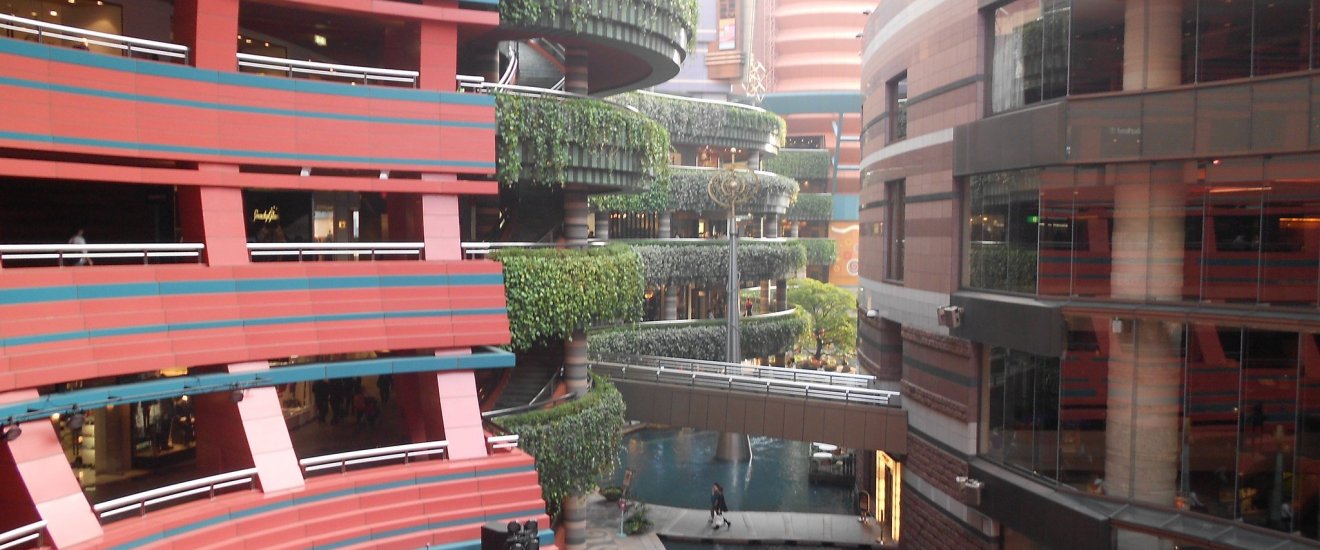
I activated my JR pass on March 16th and caught the 6:10 Shinkansen south to KUMAMOTO (pop 730,000) and was there in 40 minutes. Ten minutes later, I was on the local train 1 1/2 hours east to Aso (pop 30,000) to see the world’s largest volcanic caldera with a circumference of 128 kms. The boundary of the caldera has 5 small mountains with only Naka-dake (1506m) presently active. It erupted in 1958, 1979, 1989, 1990 an 1993 and now has a huge steam vent in the 100m deep crater. You are only allowed to walk along about 50m of the rim to see billowing steam down below. It was very cold and windy but starkly beautiful.


Back in Kumamoto by 2PM, i visited the Kumamoto Castle.
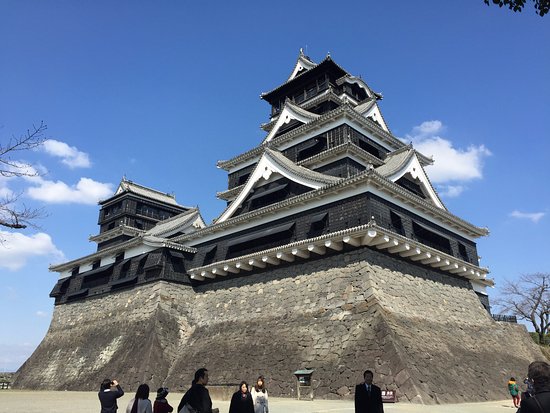
Built in 1601-07, it was destroyed in the last civil war in Japan in 1877. Rather than being dismantled by a shogun decree or imperial edict, or WWII bombings, this was an honourable destruction in a battle among Japanese. It was rebuilt in 1990 in the perfectionist Japanese way, but still has an impressive 5.3 km wall and 13 buildings including the 29.5m, seven story main palace. Two funny things occurred during the tour of the castle. At a place where pictures were not allowed, guys with red wands held up signs saying “NO PHOTOGLAPHY”. A celebrity (a movie star) was getting the deluxe tour complete with full camera crew, interviewer and minders. I was standing at a display reading the note. The celebrity came up behind and the minders had a fit as I took about 15 seconds to read. I refused to move until I was finished. The minders lost it.
Just north of the castle is the Hosokawa Gyobutel, an immaculate villa and house built for the Hosokawa clan with displays of furniture and art.
Kumamoto has no metro but relies on a tram system. I am staying in the best hostel ever in Kumamoto. It is new and built in a traditional Japanese way – squat toilets, tatami mats in the bedrooms with futons and small bean bag pillows, gorgeous wood floors, nice common room, motion activated lights and doors, on and on. One problem was the reception was open only from 4-7PM and I arrived at 2. I wanted to tour the castle and not carry my heavy pack. I simply left my pack outside in front of the hostel one meter from the sidewalk for 3 hours. Only in Japan. The slipper thing is already kind of irritating – I have four pairs of shoes here: my flip-flops for the entry, house slippers, bathroom slippers and rubber clogs for the roof terrace. Slippers are not worn on tatami mats.
YAKUSHIMA
I originally did not think I had time to see Yakushima but with all the snow in Hokkaido, I decided to return. March 29 was a huge train day where I took bullet trains all the way from Aomori on the north tip of Honshu via Tokyo, Nagoya, Osaka, Hiroshima and Fukuoka to Kagoshima on the south tip of Kyushu, basically the length of mainland Japan. It took only about 12 hours and cost about 2/3rds the value of my entire JR Pass.
I then took the ferry (15000 yen round trip) south to Myanoura on Yakushima, the largest of the Osumi Islands. Yakushima (pop 13,700) is a Unesco World Heritage Site. The island’s mountainous interior is home to the world-famous yakusugi, Cryptomeria japonica, or ancient cedar trees. The most popular hiking is to Jomon-sugi, a monster of a Jakusugi estimated to be 3000 years old.

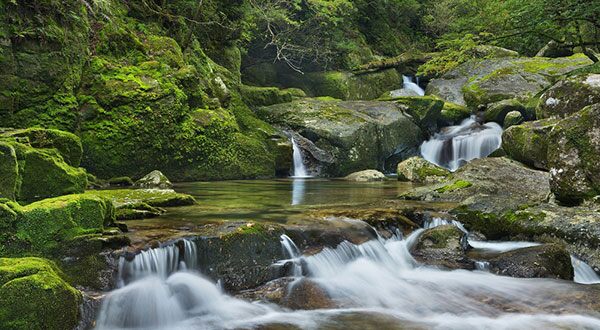
One trail is 19.5km round trip and must be started at 4AM but I took the shorter, and more beautiful trail closer to Miyanoura that goes to different trees. This area has been logged since 1600 (for shingles), and there are only a few large cedar trees in a broadleaf forest with wonderful moss and streams. We saw many habituated deer and a small troop of macaque monkeys. The large creek is gorgeous with granite boulders and stream bed and waterfalls. These cedar are not as big or nice as the western red cedar of British Columbia. Most of the lower tree has no bark, the trunks are rotten, and branches sparse and at the top.
I spent some time with a young couple from Canada teaching English in junior high and high school and were on holidays during their spring break. They had been here for 3+ years and had lots of interesting observations. Most schools have native English teachers but the kids have little interest in developing communication skills. The least interested are the best students who know they only have to learn grammar and speaking is not tested. Poorer students are often to the ones at least willing to try. Japan has a “no fail” policy and students are moved on even if they never attend school. Dropping out before graduation is not rare approaching 20%. Few of the Japanese couples they know are happily married with of marriage affairs common for both men and women. Despite this divorce is rare and people stay in awful relationships forever. Work keeps the men away from home.
BEPPU (pop 121,000).
After one night on Yakushima, I took the ferry and train north via Fukuoka to Beppu on the east coast of Kyushu. It is the onsen capital of Japan. One of the highlights is a hell area – hot spring features like mud pots and geysers not for bathing. These have all the appearance of mini-amusement parks. If you have been to Yellowstone, you will find them disappointing. I went to my first onsen, Takegawara, in a wooden building dating to the Meiji era near my hostel in town. Bathing is simple – bring your shampoo, soap, razor and wash cloth, sit on a small stool beside the pool and have a bath pouring hot water all over with a small bucket. Then soak in the pool. Very nice. The baths are sex segregated and nobody wears clothes. Cherry blossom time is in full swing.
HIROSHIMA (pop 1.48 million). Back to when I was originally in Honshu, I was woken up at 4:30 by loud dorm mates, I caught the 7:10 Shikansen to Hiroshima on southern Honshu, the main island of Japan. Nagasaki was bombed as it was a large ship yard. Hiroshima was a large naval base with its spectacular harbour. Hiroshima has no metro but relies on buses and a tram system.
Miyajima (pop 1970) is a small island south of Hiroshima. A Unesco World Heritage spot, it is one of the most visited tourist spots in Japan. The train is a 20 minute ride south followed by a JR ferry across to the island. The main attraction is Itsukushima-jinja, a Shinto shrine built in 1168. For an hour twice a day during high tide, the shrine and huge orange gate are surrounded by water making it seem to float on the waves. The rest of the time, it is surrounded by mud. Commoners were not allowed to set foot on the holy island and had to approach the shrine by boat through the gate.

The best thing to do here is to climb Mount Misen, at 530m, the highest mountain on Miyajima. A ropeway is available but there are several trails making for a very pleasant 1 1/2 hour walk. At the top are several shrines one with a flame that’s been burning continuously for 1200 years. On the very top is an observation deck with stupendous 360 degree views of Hiroshima and its splendid harbour. On the walk down, we took a different trail that ended at Daisho-in, a very nice Buddhist temple. One walks through a market to get to the shrine and mountain with souvenir shops and food stalls with oysters the main commodity.
Atomic Bomb Sites. Of course the man attraction to Hiroshima are the atomic bomb sites. The US decided to use the atomic bomb for several reasons. It was thought that it would end the war quickly especially as the war in Europe had been over for 3 months and Japan had rejected a treaty offer. The Soviet Union was about to join the Allied effort on August 8th against Japan and America wanted to end the war before that to minimize Soviet influence. Four cities had been picked to bomb including Hiroshima and Nagasaki. Hiroshima was decided on as it was believed to have no Allied prisoners of war. The bomb was to be dropped after August 3rd, and August 6 was to be a clear day in the weather forecast.
Three American B29 bombers took off with the Enola Gay carrying an atomic bomb with 50kg of uranium. It was dropped at 8:15AM shortly after an air raid siren had signalled all clear and nobody was in bomb shelters. The epicentre of the blast was 600m above a hospital and 130m SE of the only remaining evidence of the blast, the Atomic Bomb Dome. Only one kg of uranium underwent fission and about 15% of the energy released was radiation. Temperatures reached 3-4000 degrees centigrade on the ground and 90% of the buildings within 3kms collapsed. Everything within 2kms that was combustible was incinerated in the fire storm. Most people outside within one km of the epicentre died within days. 350,000 people lived in Hiroshima at the time of the blast, of which 140,000 were dead by the end of 1945.
Acute effects of radiation and heat damage lasted about 5 months including hair loss, bleeding gums, purpura and stomatitis. 20,000 school children had been evacuated from Hiroshima towards the end of the war and about 7,000 became war orphans. Besides Japanese, many Koreans (Korea was a colony of Japan and Koreans were working in Japan), some Chinese and a few American POWs died.
Nagasaki was bombed three days later. Japan surrendered on August 15th. Keloids, cataracts and microcephaly were some of the nonlethal long-term effects. About 46,000 further deaths since 1945 have been attributed to the bomb, most from leukemia and other cancers.
The only remains from the bomb is the Atomic Bomb Dome, a large concrete community hall built in 1915 that held government agencies during the war. As the blast occurred virtually over top of it, the centre concrete walls and iron frame were left standing. In 1996, it was declared a Unesco World Heritage Site.
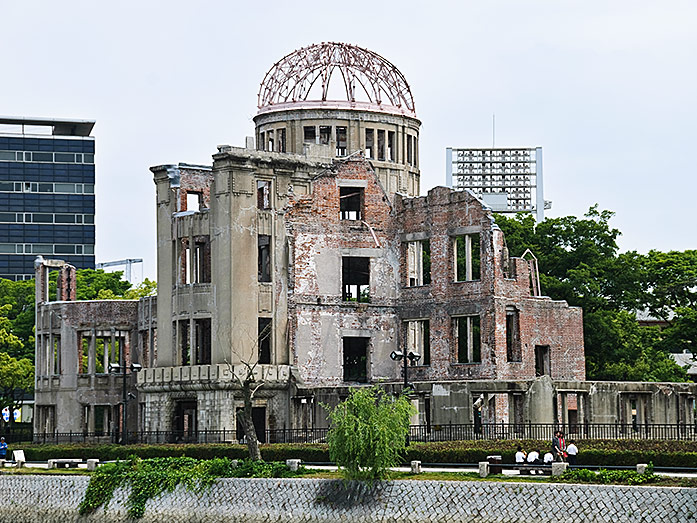
The dome sits across a small river from a huge park that was once an active community. In the park are many memorials – Bell of Peace, Children’s Peace Monument (dedicated to a girl aged two in 1945 who died of leukemia at age 10),

Atomic Bomb Memorial Mound (ashes of thousands who were cremated), an A bomb gravestone of a man buried in 1689, National Peace Memorial Hall for the Atomic Bomb Victims (records of every victim in a beautiful building), and the Cenotaph for A Bomb Victims (arch, pool and eternal flame).
The centrepiece of the park is the Peace Memorial Museum, 2 large buildings that document the history of Hiroshima, Japanese war history, and has remnants of buildings, people and possessions from the blast. Some of the poignant ones were the dark area on a stairs where a person was sitting with the surrounding stone bleached from the blast, shadows of ladders and metal valves on exposed walls, papers where the black ink absorbed more heat and only the characters are burned, and all the heat damaged roof tiles. A bank is one of the few buildings still standing that looks from the outside as it did then. “Forgive, Never Forget” is the motto of the park.
Japan had been in a warring mood since the samurai were outlawed in the 1860s. They won the Sino-Japanese War (China, gained control of Taiwan) of 1894-95, Boxer Rebellion (China) of 1900, Russio-Japanese War of 1904-5, Korea annexation since 1910, and had been at war since 1931 in China (full-scale war since 1937, 300,000 Chinese had been killed in Nanking, China) before they attacked Pearl Harbour in December, 1941.
I also went on a tour of the Mazda Factory, headquartered in Hiroshima. It was great with a good museum, technological explanations and close up views of the 7.5km long assembly line, the longest in the world.
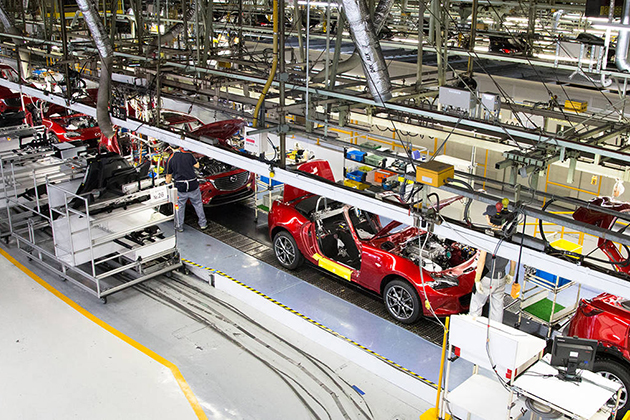
From Hiroshima, I took the Shinkansen along the east coast to Okayama and then changed to a local train to cross to the west side of Honshu to the city of Matsue (pop 200,000) on the coast. The countryside was narrow valleys and low forested hills. The local trains provide a much slower, more visually stimulating trip than the express trains. Matsue Castle is the 2nd largest, 3rd tallest, and 6th oldest of the remaining twelve original castles in Japan. It was a 20 minute walk from the train and the information desk kept my pack for me instead of paying 600 yen to store it in a locker. A moat surrounds the magnificent stone walls and the views from the 5th story watchtower were panoramic of Matsue. It was nice to see all the original wood and displays of armour and helmets. A funny sign in the toilet said “Put toilet paper in toilet. Moreover put all things other than toilet paper in the rubbish putter”.
From Matsue, I caught the train 1 1/2 hours north along the coast to Tattori (pop 200,000), a popular Japanese tourist location where tourists come to have their pictures taken with camels on the famous sand dunes. Five kms from town, the dunes stretch 10km along the coast and are at some points, 2km wide.
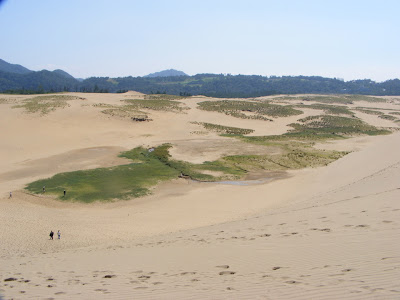
In Tottori, the only accommodation was a business hotel at $55/night. I was tired of dorm rooms and lack of sleep, so was looking forward to a nice room. I asked the lady at the information desk at the JR station to phone and see if there were rooms. I went to the hotel that I had mentioned but she had phoned a hotel across the street and apparently I had a reservation there. The people in the hotel were besides themselves as I wanted to stay in the first place. With the total lack of communication, it was hilarious to watch them fuss.
I took most of the day to get to Kyoto by train with three trains and two transfers later (one transfer was a minute between trains but I only had to cross the platform). The timing of trains is unbelievably accurate. The trip was along the coast with some nice ocean views, but most was through rural mountainous terrain. In smaller towns most houses are two-story with tiled roofs and minimal yards. It is still winter foliage but most trees are conifers. Cherry blossom time has not hit yet on March 20. 80% of Japan is mountains. Only 5% of the population is engaged in agriculture so the rest of the population is crammed into less than 20% of the land mass of the country. Tokyo/Yokahama has a metropolitan population of 35 million, the largest on the planet.
Some observations about Japan:
English communication skills are negligible. Like Korea, they take English from primary school but the teachers are not native English speakers, only grammar is taught, and they get little chance to converse. There are no English language TV stations. They are reasonable at reading English but almost completely unwilling to speak. This may be do to shyness or simply not wanting a make a mistake.
I look completely out-of-place. There are few foreigners and with the high density population, lots of Japanese. Wearing shorts is never done by Japanese. Most men will be in business suits and everyone wears long pants. Backpacks are used only by some foreigners. Japanese only travel with rolling suitcases. Like Koreans, Japanese never wear sunglasses (must be the squinty eyes), and rarely hats.
People are unbelievably helpful. Ask for directions and you inevitably have a companion showing you the way as they are so unwilling to verbalize directions. Most young people simply cross their wrists and make no effort to help. Like all non North Americans, map reading ability is zero.
There are at least five kinds of 7/11 type convenience stores, one every 100 meters or so. They all sell identical products. It is embarrassing when everything presented to you (tickets, money at stores) is done with two hands and a bow, and you take with one hand and no bow. Money is dealt with in a little tray – you put your money on it and receive your change on it. The only ATMs that work with foreign debit cards are in 7/11s and Japan Post Offices.
Garbage cans are hard to find (I carry a plastic bag in my pack just to deal with all the garbage you accumulate in a day).
Japanese never jay walk or cross a road without a walk sign. It can be a minor street with not a vehicle visible, and then will wait for the walk sign. I love to jaywalk and cross against no walking signs. I wonder what they think.
There is an incredible glut of workers doing non-essential work. The most useless are guys with red wands who control every possible danger – street crossings, busy walkways with possible bike traffic, construction sites. Surprisingly many of them are very old.
